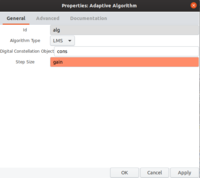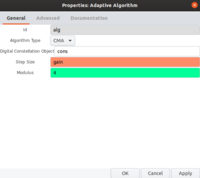Adaptive Algorithm: Difference between revisions
Jump to navigation
Jump to search
(Created page with "Category:Digital Docs Creates an Adaptive Algorithm object to be used in Linear_Equalizer or Decision_Feedback_Equalizer to define how the error signal is calculat...") |
|||
| Line 22: | Line 22: | ||
[[File:Adaptive_algorithm.png|200px]] | [[File:Adaptive_algorithm.png|200px]] | ||
[[File:Adaptive_algorithm_LMS.png|200px]] | [[File:Adaptive_algorithm_LMS.png|200px]] | ||
[[File:Adaptive_algorithm_CMA.png|200px]] | [[File:Adaptive_algorithm_CMA.png|200px]] | ||
== Source Files == | == Source Files == | ||
Revision as of 15:27, 8 April 2020
Creates an Adaptive Algorithm object to be used in Linear_Equalizer or Decision_Feedback_Equalizer to define how the error signal is calculated and how taps are updated, depending on the specified algorithm
Parameters
(R): Run-time adjustable
- Algorithm Type
- enum to specify which adaptive algorithm will be used; LMS, NLMS, CMA are the valid choices
- Digital Constellation Object
- A Constellation_Object which specifies the modulation used to adapt using decision directed mode of the equalizer
- Step Size
- Specifies how quickly the adaptive algorithm will converge. Too high and the equalizer becomes unstable. The optimal value is dependent on the statistical properties of the input signal
- Modulus
- (CMA only) Specifies the number of constellation points, e.g. for QPSK modulus = 4
Example Flowgraph
See Linear_Equalizer for a flowgraph utilizing the Adaptive Algorithm Object


